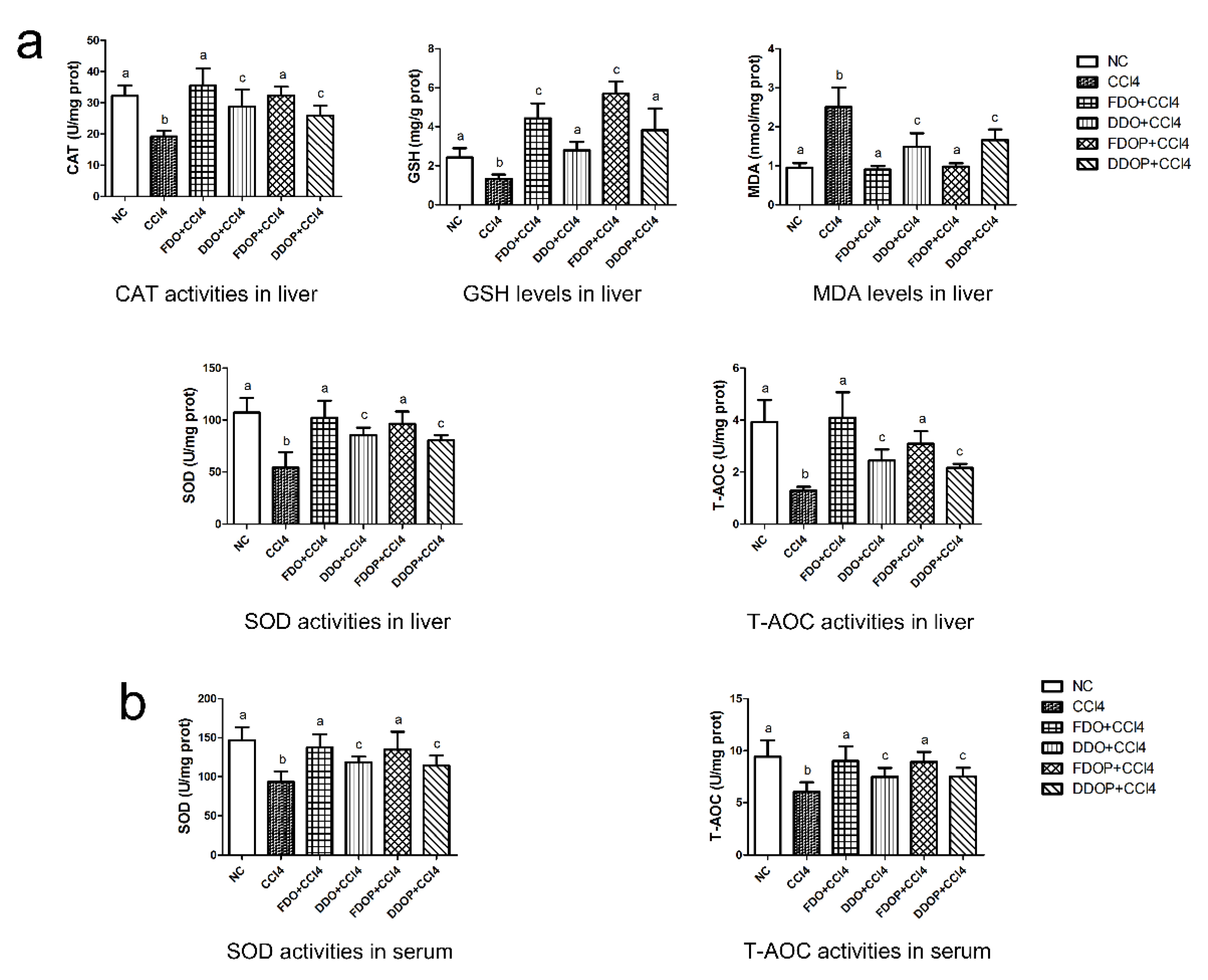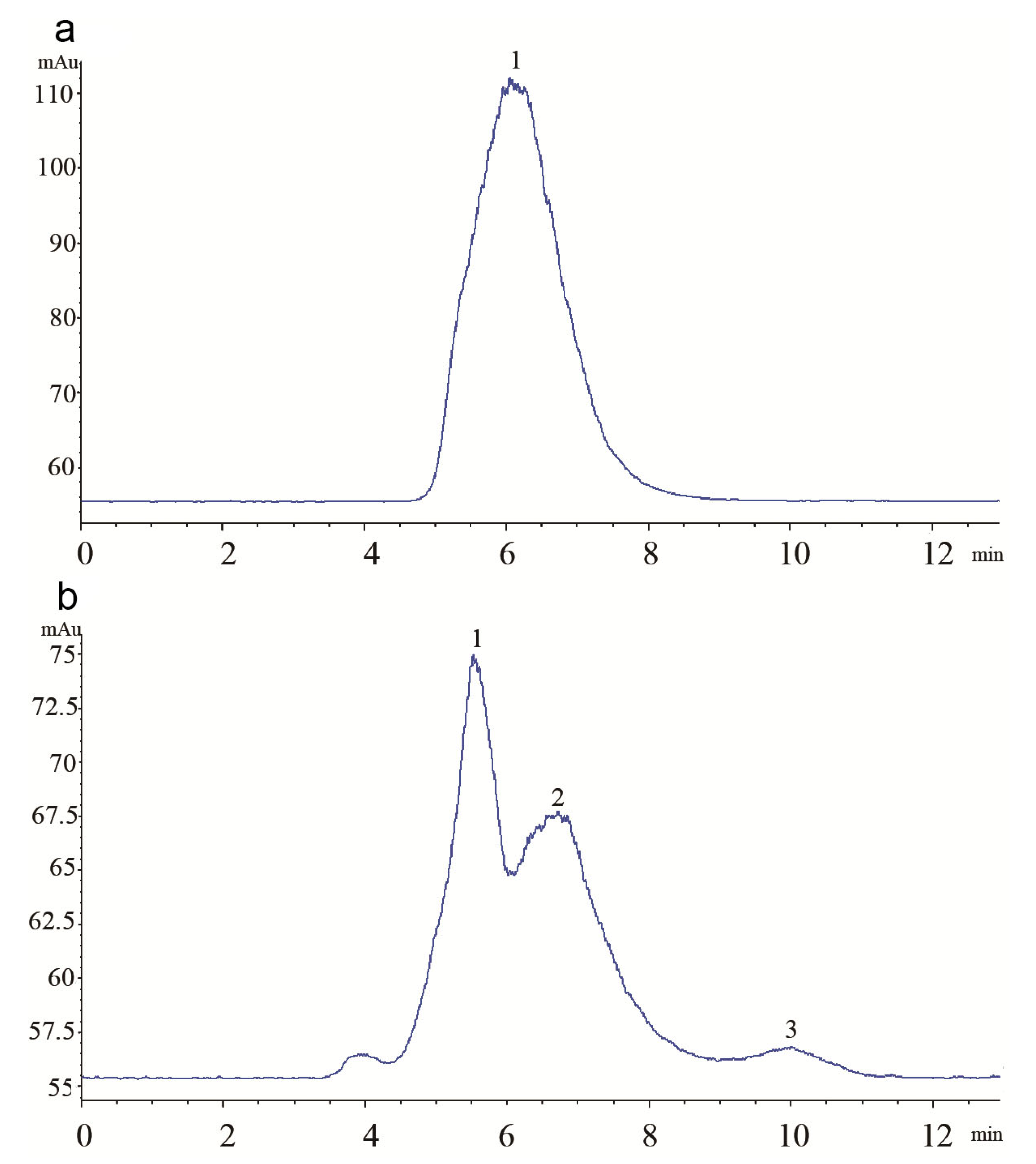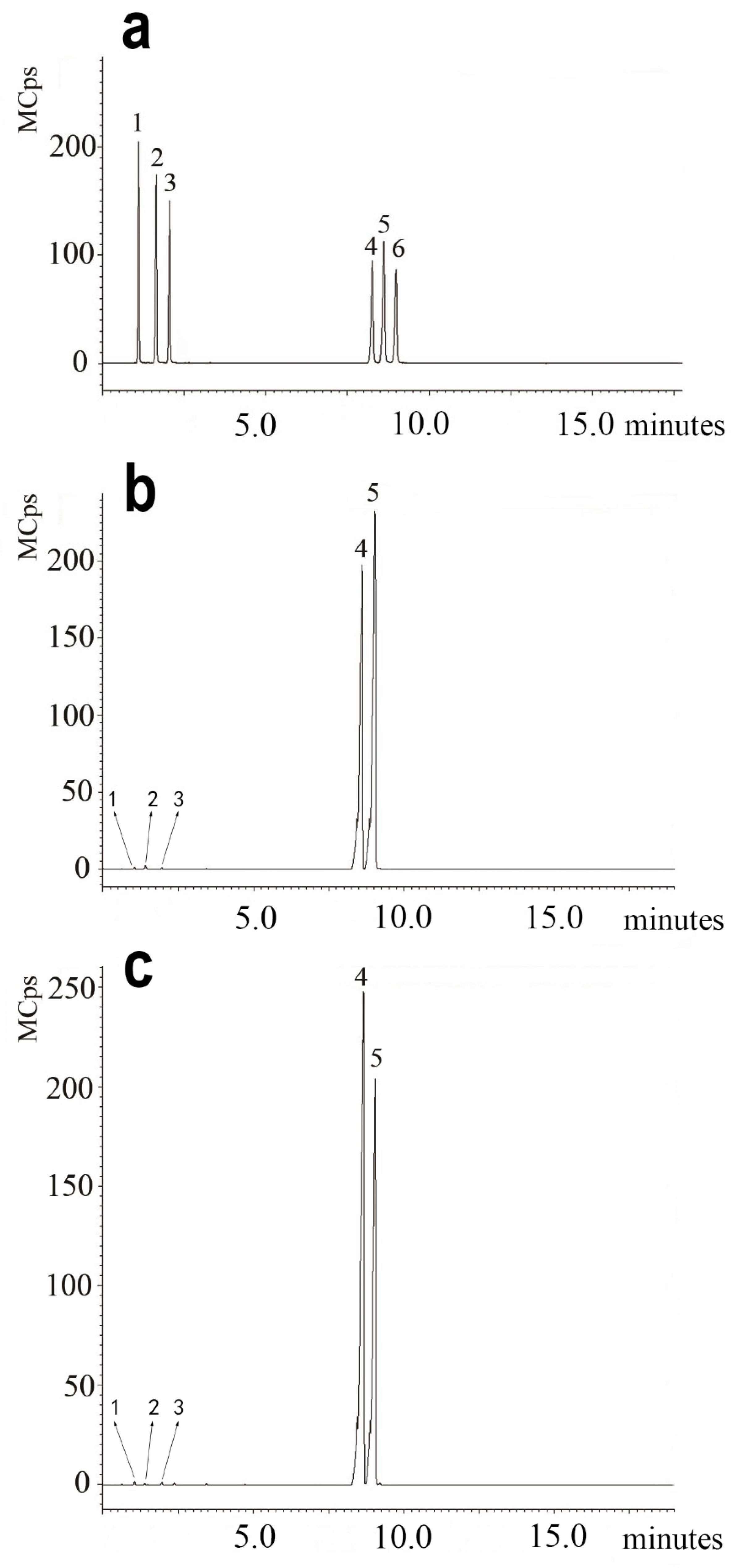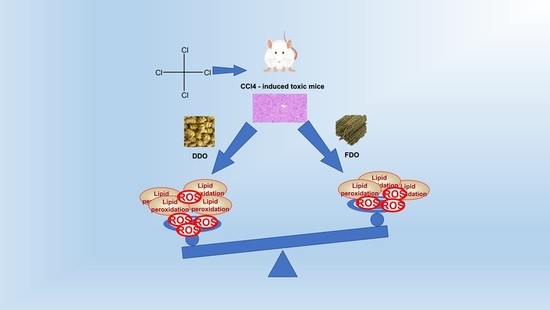Comparison of the Antioxidant Activities and Polysaccharide Characterization of Fresh and Dry Dendrobium officinale Kimura et Migo
Abstract
1. Introduction
2. Results
2.1. The Antioxidant Activity of the FDO and DDO In Vitro
2.2. The Antioxidant Activity of the FDO and DDO In Vivo
2.2.1. The Effect of the FDO and DDO on Antioxidative Parameters in the Liver and Serum
2.2.2. The Effect of the FDO and DDO on the Histopathology
2.3. The Content of Polysaccharides in the FDO and DDO
2.4. The Content of Mannose in the FDO and DDO
2.5. The Antioxidant Activity of the FDOP and DDOP In Vivo
2.5.1. The Effect of the FDOP and DDOP on the Antioxidative Parameters in the Liver and Serum
2.5.2. The Effect of the FDOP and DDOP on the Histopathology
2.6. Molecular Weight Analysis and the Monosaccharide Composition of the FDOP and DDOP
3. Discussion
4. Materials and Methods
4.1. Reagents
4.2. Plant Materials
4.3. Determination of the Antioxidant Activities of the FDO and DDO In Vitro
4.3.1. Sample Preparation
4.3.2. DPPH Radical Scavenging Activity Assay
4.3.3. ABTS Radical Scavenging Activity Assay
4.3.4. Hydroxyl Radical Scavenging Activity Assay
4.4. Assay of the Antioxidant Activities of the FDO and DDO In Vivo
4.4.1. Test Animals
4.4.2. Carbon Tetrachloride (CCl4)-Induced Oxidative Toxicity
4.4.3. Determination of the Biochemical Parameters in the Liver and Serum
4.4.4. Histopathological Examination
4.5. Extraction and Determination of the Polysaccharides in the FDO and DDO
4.6. Extraction and Determination of the Mannose in the FDO and DDO
4.7. Determination of the Antioxidant Activities of the FDOP and DDOP In Vivo
4.8. Determination of the Molecular Weight of the FDOP and DDOP
4.9. Monosaccharide Composition Analysis of the FDOP and DDOP
4.10. Statistical Analysis
5. Conclusions
Author Contributions
Funding
Institutional Review Board Statement
Informed Consent Statement
Data Availability Statement
Conflicts of Interest
Sample Availability
References
- Oikeh, E.I.; Oviasogie, F.E.; Omoregie, E.S. Quantitative phytochemical analysis and antimicrobial activities of fresh and dry ethanol extracts of Citrus sinensis (L.) Osbeck (sweet Orange) peels. Clin. Phytosci. Int. J. Phytomed. Phytother. 2020, 6, 1–6. [Google Scholar] [CrossRef]
- Zheng, Y.; Lei, L.; Liang, S.; Ai, J.; Deng, X.; Li, Y.-Q.; Zhang, T.-P.; Pu, S.-B.; Ren, Y.-S. Protective Effect of Fresh/Dry Dandelion Extracts on APAP-Overdose-Induced Acute Liver Injury. Chin. J. Integr. Med. 2021, 28, 683–692. [Google Scholar]
- Protim, M.B.; Kumar, B.P.; Phirose, K.; Gitasree, B.; Mohan, L.; Saikat, H. Thermolabile essential oils, aromas and flavours: Degradation pathways, effect of thermal processing and alteration of sensory quality. Food Res. Int. 2021, 145, 110404. [Google Scholar]
- Nascimento, L.D.; Gomes, S.S.; Moraes, C.M.; Costa, K.S.D.; Baia, F.P.L.; Leal, C.C.M.; de Aguiar Andrade, E.H.; de Faria, L.J.G. Drying Effects on Chemical Composition and Antioxidant Activity of Lippia thymoides Essential Oil, a Natural Source of Thymol. Molecules 2021, 26, 2621. [Google Scholar] [CrossRef] [PubMed]
- Lin, J.-T.; Liu, S.-C.; Hu, C.-C.; Shyu, Y.-S.; Hsu, C.-Y.; Yang, D.-J. Effects of roasting temperature and duration on fatty acid composition, phenolic composition, Maillard reaction degree and antioxidant attribute of almond (Prunus dulcis) kernel. Food Chem. 2016, 190, 520–528. [Google Scholar] [CrossRef]
- Gu, J.-F.; Zheng, Z.-Y.; Yuan, J.-R.; Zhao, B.-J.; Wang, C.-F.; Zhang, L.; Xu, Q.-Y.; Yin, G.-W.; Feng, L.; Jia, X.-B. Comparison on hypoglycemic and antioxidant activities of the fresh and dried Portulaca oleracea L. in insulin-resistant HepG2 cells and streptozotocin-induced C57BL/6J diabetic mice. J. Ethnopharmacol. 2015, 161, 214–223. [Google Scholar] [CrossRef]
- Singh, G.; Kapoor, I.P.; Singh, P.; de Heluani, C.S.; de Lampasona, M.P.; Catalan, C.A. Comparative study of chemical composition and antioxidant activity of fresh and dry rhizomes of turmeric (Curcuma longa Linn). Food Chem. Toxicol. 2010, 48, 1026–1031. [Google Scholar] [CrossRef] [PubMed]
- Papoutsis, K.; Pristijono, P.; Golding, J.B.; Stathopoulos, C.E.; Bowyer, M.C.; Scarlett, C.J.; Vuong, Q.V. Effect of vacuum-drying, hot air-drying and freeze-drying on polyphenols and antioxidant capacity of lemon (Citrus limon) pomace aqueous extracts. Int. J. Food Sci. Technol. 2017, 52, 880–887. [Google Scholar] [CrossRef]
- Choi, M.-Y.; Chai, C.; Park, J.H.; Lim, J.; Lee, J.; Kwon, S.W. Effects of storage period and heat treatment on phenolic compound composition in dried Citrus peels (Chenpi) and discrimination of Chenpi with different storage periods through targeted metabolomic study using HPLC-DAD analysis. J. Pharm. Biomed. Anal. 2011, 54, 638–645. [Google Scholar] [CrossRef]
- Sharma, K.; Ko, E.Y.; Assefa, A.D.; Ha, S.; Nile, S.H.; Lee, E.T.; Park, S.W. Temperature-dependent studies on the total phenolics, flavonoids, antioxidant activities, and sugar content in six onion varieties. J. Food Drug Anal. 2015, 23, 243–252. [Google Scholar] [CrossRef] [PubMed]
- Zhang, L.; Jiao, C.; Cao, Y.; Cheng, X.; Wang, J.; Jin, Q.; Cai, Y. Comparative Analysis and Expression Patterns of the PLP_deC Genes in Dendrobium officinale. Int. J. Mol. Sci. 2019, 21, 54. [Google Scholar] [CrossRef] [PubMed]
- Yan, L.; Wang, X.; Liu, H.; Tian, Y.; Lian, J.; Yang, R.; Hao, S.; Wang, X.; Yang, S.; Li, Q.; et al. The Genome of Dendrobium officinale Illuminates the Biology of the Important Traditional Chinese Orchid Herb. Mol. Plant 2015, 8, 922–934. [Google Scholar] [CrossRef] [PubMed]
- Yuan, H.; Lin, L.; Hao, C.; Bin, C.; Huajun, G.; Guoyu, C.; Wen, H.; Zubaydan, J.; Yizhe, Y. Research progress on extraction, purification, structure and biological activity of Dendrobium officinale polysaccharides. Front. Nutr. 2022, 9, 965073. [Google Scholar]
- He, C.; Wu, K.; Zhang, J.; Liu, X.; Zeng, S.; Yu, Z.; Zhang, X.; da Silva, J.A.T.; Deng, R.; Tan, J.; et al. Cytochemical Localization of Polysaccharides in Dendrobium officinale and the Involvement of DoCSLA6 in the Synthesis of Mannan Polysaccharides. Front. Plant Sci. 2017, 8, 173. [Google Scholar]
- Zha, X.-Q.; Luo, J.-P.; Luo, S.-Z.; Jiang, S.-T. Structure identification of a new immunostimulating polysaccharide from the stems of Dendrobium huoshanense. Carbohydr. Polym. 2006, 69, 86–93. [Google Scholar] [CrossRef]
- Huang, K.; Li, Y.; Tao, S.; Wei, G.; Huang, Y.; Chen, D.; Wu, C.; Lam, C.W.K. Purification, Characterization and Biological Activity of Polysaccharides from Dendrobium officinale. Molecules 2016, 21, 701. [Google Scholar] [CrossRef]
- Guo, L.; Qi, J.; Du, D.; Liu, Y.; Jiang, X. Current advances of Dendrobium officinale polysaccharides in dermatology: A literature review. Pharm. Biol. 2020, 58, 664–673. [Google Scholar]
- Liang, J.; Wu, Y.; Yuan, H.; Yang, Y.; Xiong, Q.; Liang, C.; Li, Z.; Li, C.; Zhang, G.; Lai, X.; et al. Dendrobium officinale polysaccharides attenuate learning and memory disabilities via anti-oxidant and anti-inflammatory actions. Int. J. Biol. Macromol. 2018, 126, 414–426. [Google Scholar] [CrossRef]
- Yang, L.; Wang, Z.; Xu, L. Simultaneous determination of phenols (bibenzyl, phenanthrene, and fluorenone) in Dendrobium species by high-performance liquid chromatography with diode array detection. J. Chromatogr. A 2006, 1104, 230–237. [Google Scholar]
- Guo, X.; Li, Y.; Li, C.; Luo, H.; Wang, L.; Qian, J.; Luo, X.; Xiang, L.; Song, J.; Sun, C.; et al. Analysis of the Dendrobium officinale transcriptome reveals putative alkaloid biosynthetic genes and genetic markers. Gene 2013, 527, 131–138. [Google Scholar] [CrossRef] [PubMed]
- Xing, S.; Yu, W.; Zhang, Y.; Luo, Y.; Lei, Z.; Huang, D.; Lin, J.; Huang, Y.; Huang, S.; Nong, F.; et al. Isoviolanthin Extracted from Dendrobium officinale Reverses TGF-β1-Mediated Epithelial-Mesenchymal Transition in Hepatocellular Carcinoma Cells via Deactivating the TGF-β/Smad and PI3K/Akt/mTOR Signaling Pathways. Int. J. Mol. Sci. 2018, 19, 1556. [Google Scholar]
- Luo, Q.-L.; Tang, Z.-H.; Zhang, X.-F.; Zhong, Y.-H.; Yao, S.-Z.; Wang, L.-S.; Lin, C.-W.; Luo, X. Chemical properties and antioxidant activity of a water-soluble polysaccharide from Dendrobium officinale. Int. J. Biol. Macromol. 2016, 89, 219–227. [Google Scholar] [CrossRef] [PubMed]
- Chu, C.; Li, T.; Pedersen, H.A.; Kongstad, K.T.; Yan, J.; Staerk, D. Antidiabetic constituents of Dendrobium officinale as determined by high-resolution profiling of radical scavenging and α-glucosidase and α-amylase inhibition combined with HPLC-PDA-HRMS-SPE-NMR analysis. Phytochem. Lett. 2019, 31, 47–52. [Google Scholar] [CrossRef]
- Yue, Y.; She, X.; Cao, X.; Yang, L.; Huang, J.; Zhang, X.; Su, L.; Wu, M.; Tong, H.; Ji, X. Comprehensive evaluation of Dendrobium officinale from different geographical origins using near-infrared spectroscopy and chemometrics. Spectrochim. Acta Part A Mol. Biomol. Spectrosc. 2022, 277, 121249. [Google Scholar]
- Yang, W.; Yu, J.; Pei, F.; Mariga, A.M.; Ma, N.; Fang, Y.; Hu, Q. Effect of hot air drying on volatile compounds of Flammulina velutipes detected by HS-SPME-GC-MS and electronic nose. Food Chem. 2016, 196, 860–866. [Google Scholar] [CrossRef]
- Tian, M.; Wu, X.; Hong, Y.; Wang, H.; Deng, G.; Zhou, Y. Comparison of Chemical Composition and Bioactivities of Essential Oils from Fresh and Dry Rhizomes of Zingiber zerumbet (L.) Smith. BioMed Res. Int. 2020, 2020, 9641284. [Google Scholar]
- Huang, X.; Nie, S.; Cai, H.; Zhang, G.; Cui, S.W.; Xie, M.; Phillips, G.O. Study on Dendrobium officinale O-acetyl-glucomannan (Dendronan®): Part VI. Protective effects against oxidative stress in immunosuppressed mice. Food Res. Int. 2015, 72, 168–173. [Google Scholar] [CrossRef]
- Zhao, Y.; Sun, Y.; Wang, G.; Ge, S.; Liu, H. Dendrobium Officinale Polysaccharides Protect against MNNG-Induced PLGC in Rats via Activating the NRF2 and Antioxidant Enzymes HO-1 and NQO-1. Oxidative Med. Cell. Longev. 2019, 2019, 9310245. [Google Scholar] [CrossRef]
- Koo, P.S.; Kyung, L.Y. Antioxidant Activity in Rheum emodi Wall (Himalayan Rhubarb). Molecules 2021, 26, 2555. [Google Scholar]
- Borawska, J.; Darewicz, M.; Vegarud, G.E.; Minkiewicz, P. Antioxidant properties of carp (Cyprinus carpio L.) protein ex vivo and in vitro hydrolysates. Food Chem. 2016, 194, 770–779. [Google Scholar] [CrossRef]
- Komaki, Y.; Simpson, A.M.-A.; Choe, J.K.; Pinney, M.M.; Herschlag, D.; Chuang, Y.-H.; Mitch, W.A. Serum electrolytes can promote hydroxyl radical-initiated biomolecular damage from inflammation. Free. Radic. Biol. Med. 2019, 141, 475–482. [Google Scholar] [CrossRef]
- Gao, Q.; Zhao, X.; Yin, L.; Zhang, Y.; Wang, B.; Wu, X.; Zhang, X.; Fu, X.; Sun, W. The essential oil of Artemisia capillaris protects against CCl4-induced liver injury in vivo. Rev. Bras. Farmacogn. 2016, 26, 369–374. [Google Scholar] [CrossRef]
- Recknagel, R.O.; Glende, E.A., Jr.; Dolak, J.A.; Waller, R.L. Mechanisms of carbon tetrachloride toxicity. Pergamon 1989, 43, 139–154. [Google Scholar] [CrossRef]
- Recknagel, R.O. A new direction in the study of carbon tetrachloride hepatotoxicity. Pergamon 1983, 33, 401–408. [Google Scholar] [CrossRef]
- Igor, A.E. Signaling and Damaging Functions of Free Radicals in Aging-Free Radical Theory, Hormesis, and TOR. Aging Dis. 2010, 1, 75. [Google Scholar]
- Kun-Chang, W.; Yu-Ling, H.; Yueh-Hsiung, K.; Shyh-Shyun, H.; Guan-Jhong, H.; Yuan-Shiun, C. Hepatoprotective Effect of Ugonin M, A Helminthostachys zeylanica Constituent, on Acetaminophen-Induced Acute Liver Injury in Mice. Molecules 2018, 23, 2420. [Google Scholar]
- Sonda, S.; Amani, A.; Mariam, F.; Lotfi, M.; Noureddine, A.; Michel, T.; Nathan, T.; Raoudha, M. Antioxidant and Antimicrobial Activities of Erodium arborescens Aerial Part Extracts and Characterization by LC-HESI-MS2 of Its Acetone Extract. Molecules 2022, 27, 4399. [Google Scholar]
- Li, Y.; Cao, Z.; Jia, L.; Huang, Y.; Shi, M.; Li, Q. Regulation of Dendrobium Polysaccharides on Proliferation and Oxidative Stress of Human Umbilical Vein Endothelial Cells in the High Glucose Environment. J. Diabetes Res. 2021, 2021, 6685055. [Google Scholar] [CrossRef]
- Zhou, D.; Zhao, Y.; Chen, Z.; Yan, X.; Zhao, Y.; Gao, L.; Yang, L. Traditional processing increases biological activities of Dendrobium offificinale Kimura et. Migo in Southeast Yunnan, China. Sci. Rep. 2022, 12, 1–19. [Google Scholar]
- Moretti, M.; Cossignani, L.; Messina, F.; Dominici, L.; Villarini, M.; Curini, M.; Marcotullio, M.C. Antigenotoxic effect, composition and antioxidant activity of Dendrobium speciosum. Food Chem. 2013, 140, 660–665. [Google Scholar] [CrossRef]
- Luo, A.; He, X.; Zhou, S.; Fan, Y.; He, T.; Chun, Z. In vitro antioxidant activities of a water-soluble polysaccharide derived from Dendrobium nobile Lindl. extracts. Int. J. Biol. Macromol. 2009, 45, 359–363. [Google Scholar] [CrossRef] [PubMed]
- Shen, Y.; Zhang, H.; Cheng, L.; Wang, L.; Qian, H.; Qi, X. In vitro and in vivo antioxidant activity of polyphenols extracted from black highland barley. Food Chem. 2016, 194, 1003–1012. [Google Scholar] [CrossRef] [PubMed]
- Chen, Y.; Huang, B.; He, J.; Han, L.; Zhan, Y.; Wang, Y. In vitro and in vivo antioxidant effects of the ethanolic extract of Swertia chirayita. J. Ethnopharmacol. 2011, 136, 309–315. [Google Scholar] [CrossRef]
- Tomáš, Z.; Petra, O.; Sinetova, M.A.; Jan, Č. Determination of Storage (Starch/Glycogen) and Total Saccharides Content in Algae and Cyanobacteria by a Phenol-Sulfuric Acid Method. Bio-Protocol 2018, 8, e2966. [Google Scholar]
- Zhang, L.; Xu, J.; Zhang, L.; Zhang, W.; Zhang, Y. Determination of 1-phenyl-3-methyl-5-pyrazolone-labeled carbohydrates by liquid chromatography and micellar electrokinetic chromatography. J. Chromatogr. B 2003, 793, 159–165. [Google Scholar] [CrossRef]
- Dreher, T.W.; Hawthorne, D.B.; Grant, B.R. Comparison of open-column and high-performance gel permeation chromatography in the separation and molecular-weight estimation of polysaccharides. Elsevier 1979, 174, 443–446. [Google Scholar] [CrossRef]
- Hua, Y.-F.; Zhang, M.; Fu, C.-X.; Chen, Z.-H.; Chan, G.Y.S. Structural characterization of a 2-O-acetylglucomannan from Dendrobium officinale stem. Carbohydr. Res. 2004, 339, 2219–2224. [Google Scholar] [CrossRef]





| Sample | Polysaccharide | Mannose |
|---|---|---|
| FDO | 512.7 ± 13.32 ** | 489.5 ± 2.757 * |
| DDO | 348.7 ± 12.82 | 291.3 ± 5.572 |
| Polysaccharide Sample | Monosaccharide Composition (Molar Ratio) | |||||
|---|---|---|---|---|---|---|
| Galactose | Glucose | Mannose | Aldose | Rhamnose | Xylose | |
| FDOP | 0.003 | 1.000 | 0.830 | 0.002 | 0.008 | - |
| DDOP | 0.0028 | 0.719 | 1.000 | 0.002 | 0.001 | - |
Publisher’s Note: MDPI stays neutral with regard to jurisdictional claims in published maps and institutional affiliations. |
© 2022 by the authors. Licensee MDPI, Basel, Switzerland. This article is an open access article distributed under the terms and conditions of the Creative Commons Attribution (CC BY) license (https://creativecommons.org/licenses/by/4.0/).
Share and Cite
Zhang, W.; Liu, X.; Sun, X.; Han, R.; Yu, N.; Liang, J.; Zhou, A. Comparison of the Antioxidant Activities and Polysaccharide Characterization of Fresh and Dry Dendrobium officinale Kimura et Migo. Molecules 2022, 27, 6654. https://doi.org/10.3390/molecules27196654
Zhang W, Liu X, Sun X, Han R, Yu N, Liang J, Zhou A. Comparison of the Antioxidant Activities and Polysaccharide Characterization of Fresh and Dry Dendrobium officinale Kimura et Migo. Molecules. 2022; 27(19):6654. https://doi.org/10.3390/molecules27196654
Chicago/Turabian StyleZhang, Wang, Xinjie Liu, Xun Sun, Rongchun Han, Nianjun Yu, Juan Liang, and An Zhou. 2022. "Comparison of the Antioxidant Activities and Polysaccharide Characterization of Fresh and Dry Dendrobium officinale Kimura et Migo" Molecules 27, no. 19: 6654. https://doi.org/10.3390/molecules27196654
APA StyleZhang, W., Liu, X., Sun, X., Han, R., Yu, N., Liang, J., & Zhou, A. (2022). Comparison of the Antioxidant Activities and Polysaccharide Characterization of Fresh and Dry Dendrobium officinale Kimura et Migo. Molecules, 27(19), 6654. https://doi.org/10.3390/molecules27196654








